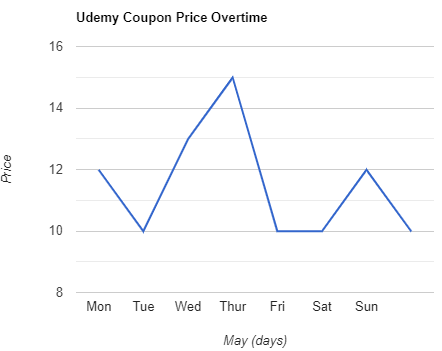Jenkins : CI/CD with Jenkins CodePipeline, AWS CodePipeline (Udemy.com)
Jenkins Certification Training Course to Automate CI/CD with Jenkins CodePipeline, AWS CodeDeploy, AWS CodePipeline
Created by: LevelUp360 Degree
Produced in 2022
 What you will learn
What you will learn
- Understand the concepts of continuous inspection, continuous integration, and continuous deployment, and the difference between them.
- Create a multi-stage Jenkins job and visualize the complicated build pipeline with Jenkins build pipeline plugin.
- In-depth knowledge about Jenkins and confidence to help your company or your own project to apply the right Jenkins workflow and continuously deliver better software.
- Key concepts of DevOps and a Continuous Delivery pipeline
- Use Jenkins Pipeline and JenkinsFile, the new concept of CI as code
- Explore Jenkins Pipeline to build, test, and deploy projects
- Work with Docker containers in a Jenkins context
- Build and test Java web applications.
 Quality Score
Quality Score
Overall Score : 72 / 100
 Live Chat with CourseDuck's Co-Founder for Help
Live Chat with CourseDuck's Co-Founder for Help
 Course Description
Course Description
What is this course about:
This course covers all the fundamentals about Jenkins and teach you everything you need to know to setup a Jenkins build pipeline starting with continuous inspection (build, test and static analysis) all the way to continuous deployment(deploy to staging and production).
In the end of this course, you will gain in-depth knowledge about Jenkins and general DevOps skills to help your company or your own project to apply the right Jenkins workflow and continuously deliver better software.
What will you learn from this lecture:
In particularly, you will learn:
- Understand the concepts of continuous inspection, continuous integration, and continuous deployment, and the difference between them.
- Build an automated continuous deployment pipeline to build, test, analyze and deploy a web-based application with Jenkins.
- Create a multi-stage Jenkins job and visualize the complicated build pipeline with Jenkins build pipeline plugin.
- Integrate CI builds with other tools such as GitHub, Maven, Tomcat, Java, etc
- Scale Jenkins workflow with Jenkins' master and slave architecture, deploy and configure a multi-node Jenkins cluster in the cloud for labeled builds.
- Learn how to configure and extend Jenkins functionality with Jenkins plugins such as copy build artifacts plugins and deploy to container plugins, etc
- Invaluable DevOps skills such as setting up staging and production environment for continuous integration workflows.
- Learn tips on how to effectively improve Jenkins build time such as executing jobs in parallel.
- Best practices of working with Jenkins in the field.
- In-depth knowledge about Jenkins and confidence to help your company or your own project to apply the right Jenkins workflow and continuously deliver better software.
- And many many more
Jenkins is on the bleeding edge of technology today. It is also one of the most compelling technologies of the last decade in terms of its disruption to software development and operation practices.
The Jenkins Continuous Integration solution has become a standby in organizations of all sizes that want to increase productivity and streamline software development in the era of Agile. It has extensive community support has the extended the core functionality of Jenkins by developing thousands of useful plugins. An ecosystem of more than 1,100 plug-ins has emerged, enabling customers to add all sorts of functionality and integrate Jenkins with everything from Active Directory to GitHub to Tomcat.
Jenkins is becoming a must tool for DevOps. It allows companies to build very sophisticated build pipelines very quickly, thus greatly reducing the risk within the software development lifecycle. Tons of companies have already been using Jenkins to implement continuous integration pipeline. Today you have the access to that same technology right on your desktop. Who this course is for:
- Anyone who want to fully understand how Jenkins works and learn how Jenkins is being used in the field.
- DevOps, developers or IT admins who want to advance their career by improving their DevOps skills.
- Anyone who want to implement or improve their continuous integration/continuous deployment workflow at their company
 Instructor Details
Instructor Details

- 3.6 Rating
 60 Reviews
60 Reviews
LevelUp360 Degree
Sometimes, reaching out and taking someone's hand is the beginning of a journey. We often need someone to helps us take the first few steps before we get a master in that move.
This is the vision we have behind all of our courses 'Step by Step'
1. Start from scratch
2. Break down the topic
3. Simplify things
4. Go step by step
Teaching is my passion and I design every course so you can start from scratch, knowing nothing about a topic and become an expert after the course and can work on enterprise projects.
I am working as a DevOps Professional in IT industry and having experience on many technologies.
Do not worry if you do not have any existing knowledge on the subject. We will go very basic, step by step.
Let's Get Started...
Anshul Chauhan
********************************************************************
All courses under our banner comes with life-time support and you can ask me questions whenever you face any issues or just want to discuss anything with me or need my suggestions.
********************************************************************







